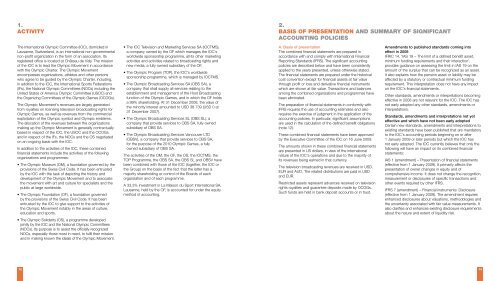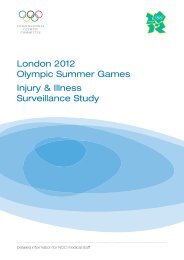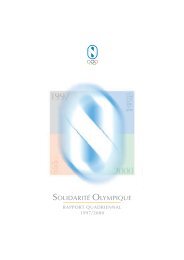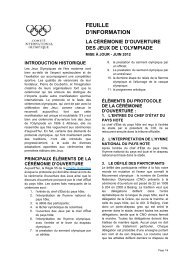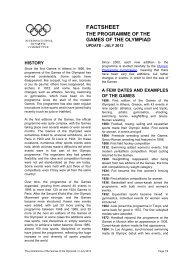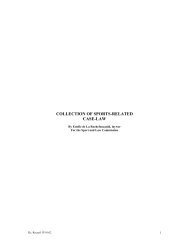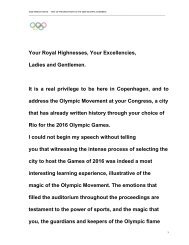3912 reportcomplete final web:layout 1
3912 reportcomplete final web:layout 1
3912 reportcomplete final web:layout 1
You also want an ePaper? Increase the reach of your titles
YUMPU automatically turns print PDFs into web optimized ePapers that Google loves.
1.<br />
ACTIVITY<br />
The International Olympic Committee (IOC), domiciled in<br />
Lausanne, Switzerland, is an international non-governmental<br />
non-profit organization in the form of an association. Its<br />
registered office is located at Château de Vidy. The mission<br />
of the IOC is to lead the Olympic Movement in accordance<br />
with the Olympic Charter. The Olympic Movement<br />
encompasses organizations, athletes and other persons<br />
who agree to be guided by the Olympic Charter, including,<br />
in addition to the IOC, the International Sports Federations<br />
(IFs), the National Olympic Committees (NOCs) including the<br />
United States of America Olympic Committee (USOC) and<br />
the Organizing Committees of the Olympic Games (OCOGs).<br />
The Olympic Movement’s revenues are largely generated<br />
from royalties on licensing television broadcasting rights for<br />
Olympic Games, as well as revenues from the commercial<br />
exploitation of the Olympic symbol and Olympic emblems.<br />
The allocation of the revenues between the organizations<br />
making up the Olympic Movement is generally contractually<br />
based in respect of the IOC, the USOC and the OCOGs,<br />
and in respect of the IFs, the NOCs and the OS negotiated<br />
on an ongoing basis with the IOC.<br />
In addition to the activities of the IOC, these combined<br />
financial statements include the activities of the following<br />
organizations and programmes:<br />
The Olympic Museum (OM), a foundation governed by the<br />
provisions of the Swiss Civil Code. It has been entrusted<br />
by the IOC with the task of depicting the history and<br />
development of the Olympic Movement and to associate<br />
the movement with art and culture for specialists and the<br />
public at large worldwide.<br />
The Olympic Foundation (OF), a foundation governed<br />
by the provisions of the Swiss Civil Code. It has been<br />
entrusted by the IOC to give support to the activities of<br />
the Olympic Movement notably in the areas of culture,<br />
education and sports.<br />
The Olympic Solidarity (OS), a programme developed<br />
jointly by the IOC and the National Olympic Committees<br />
(NOCs). Its purpose is to assist the officially recognized<br />
NOCs, especially those most in need, to fulfil their mission<br />
and in making known the ideals of the Olympic Movement.<br />
72<br />
The IOC Television and Marketing Services SA (IOCTMS),<br />
a company owned by the OF which manages the IOC’s<br />
worldwide sponsorship programme, all its other marketing<br />
activities and activities related to broadcasting rights and<br />
new media, a fully owned subsidiary of the OF.<br />
The Olympic Program (TOP), the IOC’s worldwide<br />
sponsorship programme, which is managed by IOCTMS.<br />
The Olympic Broadcasting Services SA (OBS SA), a<br />
company that shall supply all services relating to the<br />
establishment and management of the Host Broadcasting<br />
function of the Olympic Games, and in which the OF holds<br />
a 99% shareholding. At 31 December 2008, the value of<br />
the minority interest amounted to USD 38 739 (USD 0 at<br />
31 December 2007).<br />
The Olympic Broadcasting Services SL (OBS SL), a<br />
company that provide services to OBS SA, fully owned<br />
subsidiary of OBS SA.<br />
The Olympic Broadcasting Services Vancouver LTD<br />
(OBSV), a company that provide services to OBS SA,<br />
for the purpose of the 2010 Olympic Games, a fully<br />
owned subsidiary of OBS SA.<br />
The activities of the OM, the OF, the OS, the IOCTMS, the<br />
TOP Programme, the OBS SA, the OBS SL and OBSV have<br />
been combined with those of the IOC (together, the IOC or<br />
the Group) on the basis of the fact that the latter has a<br />
majority shareholding or control of the Boards of each<br />
organization and of each programme.<br />
A 33.3% investment in La Maison du Sport International SA,<br />
Lausanne, held by the OF, is accounted for under the equity<br />
method of accounting.<br />
2.<br />
BASIS OF PRESENTATION AND SUMMARY OF SIGNIFICANT<br />
ACCOUNTING POLICIES<br />
A. Basis of presentation<br />
The combined financial statements are prepared in<br />
accordance with and comply with International Financial<br />
Reporting Standards (IFRS). The significant accounting<br />
policies are described below and have been consistently<br />
applied to the years presented, unless otherwise stated.<br />
The financial statements are prepared under the historical<br />
cost convention except for financial assets at fair value<br />
through profit or loss and derivative financial instruments<br />
which are shown at fair value. Transactions and balances<br />
among the combined organizations and programmes have<br />
been eliminated.<br />
The preparation of financial statements in conformity with<br />
IFRS requires the use of accounting estimates and also<br />
requires the exercise of judgment in the application of the<br />
accounting policies. In particular, significant assumptions<br />
are used in the calculation of the defined benefit obligations<br />
(note 12).<br />
These combined financial statements have been approved<br />
by the Executive Committee of the IOC on 16 June 2009.<br />
The amounts shown in these combined financial statements<br />
are presented in US dollars, in view of the international<br />
nature of the IOC’s operations and due to the majority of<br />
its revenues being earned in that currency.<br />
The television broadcasting revenues are received in USD,<br />
EUR and AUD. The related distributions are paid in USD<br />
and EUR.<br />
Restricted assets represent advances received on television<br />
rights royalties and guarantee deposits made by OCOGs.<br />
Such funds are held in bank deposit accounts or in trust.<br />
Amendments to published standards coming into<br />
effect in 2008<br />
IFRIC 14, ‘IAS 19 – The limit of a defined benefit asset,<br />
minimum funding requirements and their interaction’,<br />
provides guidance on assessing the limit in IAS 19 on the<br />
amount of the surplus that can be recognized as an asset.<br />
It also explains how the pension asset or liability may be<br />
affected by a statutory or contractual minimum funding<br />
requirement. This interpretation does not have any impact<br />
on the IOC’s financial statements.<br />
Other standards, amendments or interpretations becoming<br />
effective in 2008 are not relevant for the IOC. The IOC has<br />
not early adopted any other standards, amendments or<br />
interpretations.<br />
Standards, amendments and interpretations not yet<br />
effective and which have not been early adopted<br />
Certain new standards, amendments and interpretations to<br />
existing standards have been published that are mandatory<br />
to the IOC’s accounting periods beginning on or after<br />
1 January 2009 or later periods but which the IOC has<br />
not early adopted. The IOC currently believes that only the<br />
following will have an impact on its combined financial<br />
statements:<br />
IAS 1 (amendment) – Presentation of financial statements<br />
(effective from 1 January 2009). It primarily affects the<br />
presentation of owner changes in equity and of<br />
comprehensive income. It does not change the recognition,<br />
measurement or disclosures of specific transactions and<br />
other events required by other IFRS.<br />
IFRS 7 (amendment) – Financial instruments: Disclosure<br />
(effective from 1 January 2009). The amendment requires<br />
enhanced disclosures about valuations, methodologies and<br />
the uncertainty associated with fair value measurements. It<br />
also clarifies and enhances existing disclosure requirements<br />
about the nature and extent of liquidity risk.<br />
73


